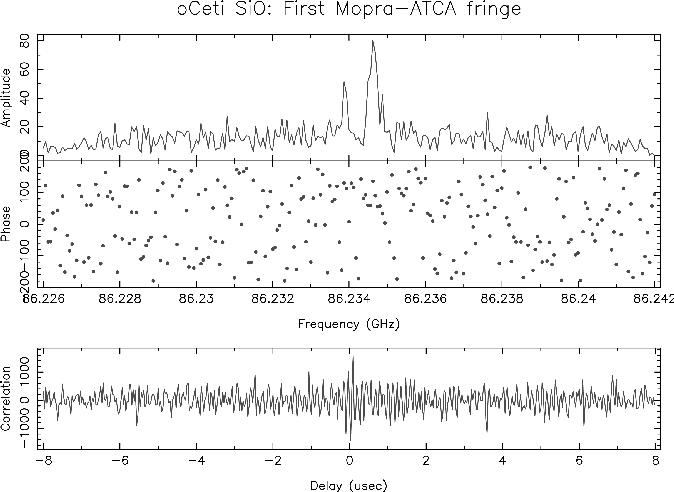Long Baseline Array news
In collaboration with the University of Tasmania and Swinburne University of Technology, we have been developing new disk-based recorders that interface with the existing data acquisition systems. These systems are based on a plug-in digital interface card built by Metsahovi Radio Observatory, Finland, and record the raw 2-bit sampled baseband data onto normal PC hard-disk drives. We have been using Apple Xserve RAID systems as well as an array of four normal PC disks with no special hardware.
Disk-based recording allows wider recorded bandwidth than the current tape-based S2 recorders, interface directly with software correlators (which are being developed at Swinburne as part their contribution to SKA developments), and are a possible replacement for the aging S2 systems. Numerous tests involving the full Long Baseline Array (LBA) plus international telescopes have been run since 2003 and correlated on the Swinburne software correlator. These tests have all run very successfully and disk-based recording, with software correlation, has been added as a standard observing mode for the OCT05 observing semester. Currently a recording rate of 512 Mbps (4 × 16 MHz bands) at Parkes, Mopra and the ATCA is available and 256 Mbps at the other LBA stations. Within the next six months we plan on doubling the recording rate to 1 Gbps at the ATNF stations and to 512 Mbps elsewhere. Anyone wanting to submit an LBA proposal using the disk-based recording must contact the LBA National Facility. Details are given on the website at www.atnf.csiro.au/vlbi/documentation/VLBI_National_Facility_upgrade.html .
Disk-based recording is the first step towards e-VLBI, which has a long term aim of removing the requirement to record the sampled data onto temporary media (i.e. tapes or disks) and directly connecting the observatories with wide bandwidth network links. CSIRO is participating in the AARNET Regional Network and we expect to have Parkes, Mopra and the Compact Array connected to 1-Gbps network links by the end of 2005. This will allow us to do real-time (or near real-time) VLBI correlation of the three ATNF antennas at a data rate of 512 Mbps. The University of Tasmania has also recently been awarded a LEIF grant to connect the Mount Pleasant observatory (near Hobart) to the University. Once fast network links on Basslink are available in the near future, the 26-m telescope in Hobart will also be connected to the real-time VLBI network.
One advantage of the disk-based recorders is that they can record data in parallel with the existing S2 systems. For the last four VLBI sessions we have been using these systems to make real-time fringe checks to all LBA stations. A small amount of data (0.1 – 1 seconds only) is captured from each observatory and sent to Swinburne using a specifically written suite of programs. The data is then correlated on the Swinburne software correlator and the result posted on a webpage. Currently the program runs interactively, but has been written to easily allow scheduled operation if this becomes desirable. The real-time fringe checker is now run routinely for all VLBI experiments and has caught a number of set-up problems that would otherwise have gone unnoticed until correlated weeks later. LBA users should be aware that they significantly increase the chance of problems being found if they schedule a strong fringe finder near the beginning of their experiment (and preferably every few hours).
One of the problems with wide-bandwidth, long-haul networks is efficiently utilising the full bandwidth as existing network protocols are not well tuned for this purpose. For example, on the dedicated 1-Gbps link experiment set up for the Huygens experiment from the ATNF headquarters in Sydney to JIVE in the Netherlands, standard networking protocols could only be used to send data at 10 Mbps which is only 1% utilisation. To help us experiment with a variety of data transport protocols, the CSIRO CeNTIE project has provided access to a 1-Gbps link from Marsfield in Sydney to the University of Western Australia in Perth.
e-VLBI is rapidly being developed around the world, especially in Europe, USA and Japan. An annual e-VLBI international workshop has been held in the last four years, with the most recent workshop (12 – 15 July 2005) hosted by Australia at the ATNF headquarters in Marsfield. About 50 participants from around the world attended and it was very successful. A special "networks" day was held, with extensive participation from the computer networking community, and this led to very useful cross-discipline links. All the presentations from this workshop are available on-line at
www.atnf.csiro.au/vlbi/evlbi2005/abstract.html.
Chris Phillips and Tasso Tzioumis
Chris.Phillips@csiro.au and Tasso.Tzioumis@csiro.au)

Figure 1: First VLBI fringes at 3-mm between ATCA and Mopra. The correlation is for a 10-second integration on the 86-GHz SiO maser oCeti. The top two panels show the power and phase spectrum, while the lower panel shows the correlation function. This data was correlated using the Swinburne software correlator used for real-time fringe finding.
At the end of August, VLBI at 86 GHz was attempted for the first time between Mopra and the Compact Array (currently the highest frequency that the LBA operates at is 22 GHz). Three hours of Director's time was used for an ad-hoc experiment. Good fringes were detected for the SiO maser emission from the source o Ceti using a 10-second integration, see Figure 1. Full correlation of the data has been done on the Swinburne software correlator and awaits analysis. 3-mm wavelength observing is not available for standard LBA observations; however interested observers should contact the ATNF if they have a strong scientific need to observe at these frequencies.
Chris Phillips and Tasso.Tzioumis
Chris.Phillips@csiro.au and Tasso.Tzioumis@csiro.au)
